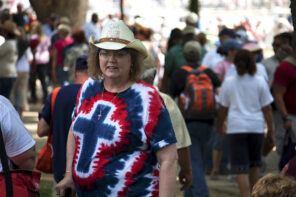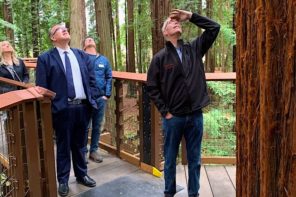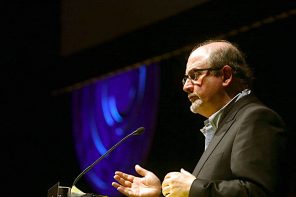The recently-published American Religious Identification Survey (ARIS), compiling the results from nearly 55,000 Americans, made headlines this week for the trends it revealed in the nation’s religious landscape: Christianity is losing ground, more and more Americans claim to have “no religion,” and the number of Muslims has doubled, to name only a few. Jews seem to be disappearing—the religious ones, anyway; evangelicals are increasing their numbers as the mainline churches continue to shrink; and new religious communities like Wicca continue to grow in popularity.
The usual pundits and pontificators have made their proclamations right out of the gate: USA Today portrays the “piety gap” (separating those who believe in a personal god from those who do not) as especially relevant in the ongoing culture wars; CNN’s “Americans becoming less Christian,” focuses on the cultural sea change, with more and more people comfortably acknowledging that they have “no religion”; and Beliefnet strongly denies that Americans are rejecting faith, claiming instead that we should be celebrating the individualistic indications of the poll—that Americans simply want faith on their own terms.
On the one hand we can thank God for polls and surveys that monitor how Americans identify their religious preferences and identities. But on the other, who really needs God to be religious anyway? And do these polls really capture the spiritual landscape in all of its complex, contradictory, and confounding realities? It would be neat and easy if a simple question, like “Do you believe in God?” had the ability to get to the heart of religious life for most Americans. But in fact the spiritual realities are simply not reducible to these narrow questions and a facile, multiple-choice perspective.
Elvis and Drugs
What if there were more to religious life in America than belief in God? More holy possibilities than those outlined in the so-called “Great Religions of the Book”—Judaism, Christianity, and Islam—or other sacred texts like the Upanishads in Hinduism or the Tibetan Book of the Dead in Buddhism?
What if religion is better understood as a ubiquitous feature of cultural life, expressed through and inspired by basic, universal facts of life and fundamentally biological phenomena in human experience: suffering and ecstasy, reproduction and aging, family and conflict, health and death.
To get here, the question must change, from “Do you believe in God?” or “What is your religious affiliation?” to something like, “What is most sacred in your life?” Even though perceptions of the sacred are neither consistent across cultures nor within them, signs of religious life often hinge on a constellation of questions that resonate throughout human history and around the globe:
What gives life meaning to individuals? Why is there life, as well as death and suffering? How do we live the good life, find happiness, purpose, and fulfillment? Where can we locate truth, or some kind of ultimate source of values and morality that is worth our spiritual and material investments? Who deserves our friendship and support and who is the enemy that must be destroyed?
The answers to these questions, and therefore the shape and content of the sacred, depends on physical acts and social engagements embedded in everyday life as much as formal religious teaching handed down from authorities in an institutional setting.
Asking questions about what is sacred opens up an entirely different can of worms. Communities have a lot invested in the sacred—everything is at stake, so individuals will give their lives to preserve and protect it; or profane and plunder what is most sacred to the outsider. In various cultures, the religious life is anchored in totems or natural phenomena; in shamanic experiences or astrological signs; in oracles or amulets. In contemporary American society, religious life without God and beyond the reach of religious traditions is anchored in a range of social phenomena that provide people with order, meaning, purpose—critical ingredients that mix together in the pursuit and experience of the sacred but that often exist under the radar of unsophisticated survey questions.
So what if the sacred is not only, or even primarily, tied to theology or religious identity labels like more, less, and not religious? We might see how religious practices and commitments emanate from unlikely sources today: science and the pursuit of truth; music and the social ecstasy of concerts; violence and the glorification of warfare; celebrity worship and technological wonders; heroic doctors and evil villains; funereal spectacles and sexual compulsions; the Super Bowl and sacrificed soldiers; Elvis and drugs, both legal and illegal.
These and other areas of fascination and fixation, often intermingled with fear and trembling, awe and faith, speak to the breadth and depth of religious cultures in America. But unhinged from standard notions of religious tradition, these spiritual anchors that are so profoundly important in the lives of Americans are left unspoken, or worse, evaluated as false religion, or even as signs of the apocalypse.
Religion is Messy and Shape-Shifting
Attention to what is sacred—sacred matters—points instead to robust, thriving forms of religious life, experience, and community that are less about theology and more about anthropology; less focused on the narrow category of monotheism and more on the sacred as the defining mark of gods and religious life generally, but also as a fundamental characteristic of social life; less constrained by religious traditions as the only source of access to the sacred, and more attentive to the flexibility, fluidity, and indeed the true messiness of religious life.
And religious life is often very, very messy. Today more than ever we have become aware of an important fact: religion can no longer be understood as a separate sphere of social life, neatly compartmentalized and privatized, set apart from economics, entertainment, education, or politics. Religious sensibilities seep deeply into and permeate every part of who we are and how we live, driving personal, community, and national attempts to create order out of disorder, meaning in the face of suffering, and hope when all seems lost. The sacred, in other words, is a force to be reckoned with in almost any social situation, even though it cannot be reduced to one essence, like God, or identified by one standard of measurement, like adherence to the Bible.
The sacred is a robust, dynamic, shape-shifting force that now more than ever is free-floating and disconnected from conventional anchors, like specific texts such as the Qur’an or particular institutions like the church, cut loose in the cultural sea of rock stars and casinos, virtual memorials and Viagra. It can be confusing as well, because individuals can exhibit, indeed embody, contradictory forms of sacred life: the prominent evangelical risking it all for secret, consecrated encounters with hookers; the liberal Jew openly devoted to the Star Wars saga; the Hindu doctor who performs miracles with modern healing technologies. Simplistic and clean divisions separating sacred and secular no longer hold up in this complex cultural arena of interpenetrations and cross-fertilizations.
Put another way, ostensibly secular aspects of social life—like sports, music, science, violence, or sexuality—can have meaningful religious dimensions in practice and experience that have nothing to do with God or religious traditions. Additionally, religious encounters and exchanges often, but not always, draw from and are informed by concepts and rituals from world religions. For example, devoted fans who make a pilgrimage to Graceland because of their love for Elvis are enacting a well-known ritual pattern toward saints in the history of Christianity; or modern-day physicists who look to Eastern mysticism to understand and explain subatomic mysteries that elude standard forms of measurement. If you take God and religious traditions out of the picture, what is left of religious life?
With these kinds of notions in mind, a truly accurate and comprehensive survey would capture a social terrain that is not spiritually desolate, but instead abundantly religious and blooming with sacred icons, popular devotions, deep-rooted mythologies, and other signs of spiritual vivacity. It would demonstrate that people can inhabit multiple religious cultures at one time, be in contact and interact meaningfully with diverse sacred anchors in their lives. These multiple sacred worlds can be in harmony or in conflict; they may be contradictory or supplementary, but they all point to powerful forces in social life that provide real-life sources for meaning, order, and transformation in daily life. Channels of communication and expression in this environment are virtually limitless, with virtual reality, popular culture, and the streets in towns and cities throughout the nation providing the playing field on which religious dreams and desires, reflections and meaningful practices, infuse life with values to live by.
Much public attention about signs of religious life in America is directed to God, front and center throughout, and increasingly to the realities of religious diversity. But this narrow theological and tradition-based view leaves a variety of alternative, though equally powerful, sacred sources buried and undetected. Someone needs to imagine a poll, a series of questions that excavates this spiritual ground and brings some of them to the light of public consciousness. The overriding results would show how Americans are even more, not less, religious than they think, and prove that God and religious traditions are not necessary to see how creatively religious the believers and the “nones” are in our contemporary spiritual landscape.




